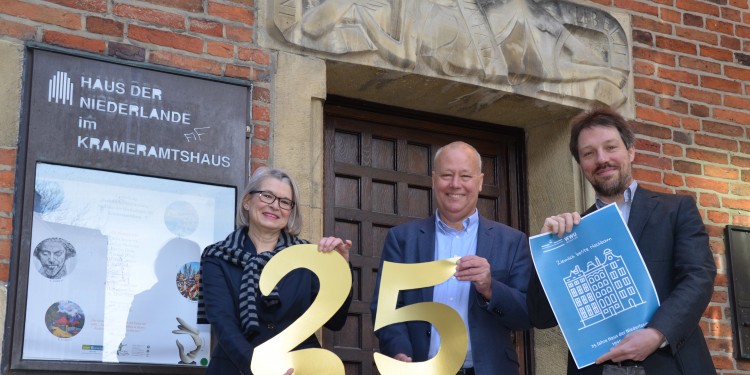
Netherlands House celebrates 25th anniversary
The words need to be chosen carefully when talking about relations between Germany and the Netherlands. There have, after all, been some pitfalls in the countries’ joint history. On the other hand, there are many noticeable similarities and, not least, close links at a European level – none of which means that the characteristic features which both nations have should, or can, be erased. Language, culture and perhaps, too, the view of the world: some things are separate, but even more are linked.
So the two countries are “quite the best of neighbours” – in Dutch, “tamelijk beste buren” – and that is also an achievement to which Netherlands House has contributed. Opened on 15 May 1995, the House will be celebrating its 25th anniversary in a few weeks’ time. At the opening there were two crown princes present – Willem Alexander, today the King of the Netherlands, and Philippe, who is now the King of the Belgians. And there could hardly been a site more steeped in history chosen for Netherlands House than the Krameramtshaus building in the centre of Münster.
In 1648 the Peace of Westphalia, signed in Münster and Osnabrück, brought the Thirty Years’ War to an end. At the same time, a further agreement was concluded – the Spanish-Dutch Treaty. This led to international recognition of the Dutch Republic and thus marks the country’s birth. The Dutch negotiators had taken up residence in the Krameramtshaus.
It is, then, the appropriate site for Netherlands House, which is today one of the most important points of contact in German-speaking countries for everything relating to the Netherlands. What is certainly helpful is that, under this one roof, another trio of ‘quite the best of neighbours’ act separately but work together, for example in the field of PR work or in staging exhibitions. The three organisations in question are the Centre for Netherlands Studies (ZNS), headed by Prof. Friso Wielenga, the Institute of Dutch Philology (INP) under Prof. Gunther De Vogelaer, and the Netherlands House Library (BHN) managed by Ilona Riek.
One overarching focus is, naturally, the Dutch language. “When German people start to learn Dutch, they often feel slightly euphoric because they understand a lot quite quickly,” says Gunther De Vogelaer. “But there are differences, and we need specific methods for teaching and learning the language.” This is particularly important because there is a large and growing number of students training to be teachers of Dutch. After all, Dutch as a language is a firm part of the German school curriculum. Just as sought-after as teachers of Dutch are university graduates who are knowledgeable regarding both Germany and the Netherlands.
Anyone wanting to investigate Dutch politics, business, history, art and intercultural communication will find what they are looking for at the ZNS. “Something unique which we have are the two multidisciplinary courses – bachelor and master – that we offer in Dutch-German Studies,” says Friso Wielenga. The necessary practical experience is provided by students on the bachelor’s course spending one semester in the Netherlands, while master’s students spend a year at the University of Nijmegen to complete the joint degree. Internships with a German-Dutch reference are also a component of the two courses.
In order to ensure that there are enough students in the future, there is an increasing focus on work done in schools. For example, the ZNS will be reviving and updating a project which ran some years ago, which makes available to schoolchildren on each side of the Dutch/German border material relating to the neighbouring country and its language. And a digitalisation project being run by the INP is aimed specifically at ten-year-olds at school, providing them with dual-language information in Biology and History.
Naturally enough, research work is also carried out at Netherlands House and here, if not before, is where the Library makes its entrance as the third player in the trio. 25 years ago, the Library brought together several individual collections of books and, according to Ilona Riek, it is now – with its broad, multidisciplinary specialist collection – “the largest library in Germany, if not far beyond, specialising in Dutch culture.”
“One of our guiding principles is to offer academic and scientific literature which is difficult, or even impossible, to get hold of at other locations in Germany – with digital or retrospectively digitalised publications becoming increasingly important,” Ilona Riek explains. “We’re guided by current requirements as well as by possible future research interests,” she adds. To this end, the Library is closely linked to the specialist information service for Benelux / Low Countries Studies run by Münster University Library.
So Netherlands House contributes to a better understanding between Germany and the Netherlands on many levels. But how are neighbourly relations between the two? “At the moment, very good,” says Friso Wielenga. “But we can’t take that for granted. In a Europe which is in crisis, we have to strengthen and deepen our relations. If we lose what have in Europe, that would indeed be dramatic.”
Author: Susanne Wedlich
+++
Due to the current situation, the celebrations to mark the 25th anniversary are being postponed. Netherlands House will be posting updates on its website and on Facebook.
+++
This article was first published in the University newspaper wissen|leben No. 2, April 2020.
